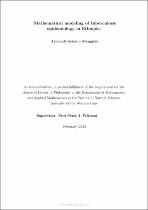| dc.contributor.advisor | Witbooi, Peter J | |
| dc.contributor.author | Mengistu, Ashenafi Kelemu | |
| dc.date.accessioned | 2024-04-04T09:17:51Z | |
| dc.date.available | 2024-04-04T09:17:51Z | |
| dc.date.issued | 2024 | |
| dc.identifier.uri | http://hdl.handle.net/11394/10710 | |
| dc.description | Philosophiae Doctor - PhD | en_US |
| dc.description.abstract | Tuberculosis (TB) is currently one of the most severe public health issues in Ethiopia and many other countries. Despite demanding efforts having been made by governmental and nongovernmental organizations to eliminate tuberculosis, it is still a severe health problem in Ethiopia. It is one of the significant causes of mortality and morbidity. Scientific studies of the dynamics of tuberculosis play an essential role in eliminating it, and mathematical models contribute significantly to this effort. Mathematical models have been used for decades to study tuberculosis’s transmission dynamics and develop strategies to prevent TB spread in various countries. However, there are insufficient intensive studies of TB dynamics using mathematical models in Ethiopia. This thesis aims to develop a modified TB dynamics model and propose an optimal TB prevention and control strategy for Ethiopia. The study examined five different scenarios. In the first scenario, a mathematical model for the transmission dynamics of TB by including BCG vaccination for newborns is developed. The global stability of the disease-free equilibrium point is determined using the Lyapunov theory. Sensitivity coefficients of the reproductive number are calculated to examine control measures’ effectiveness. The results quantify the positive influence of vaccination and the treatment for high-risk latent and active TB patients on tuberculosis control. The second instance incorporates a saturated incidence rate on the previous model. Positive solutions to the model are shown to exist and be unique. The stability of the equilibria is established. It is found that the most effective methods to control the spread of tuberculosis in Ethiopia are through minimizing the contact between TB-infected and susceptible individuals and increasing access to treatment for latently infected individuals. Furthermore, three time-dependent controls (distancing, case holding, and casefinding) are introduced into a TB model to find an optimal control strategy that minimizes the number of exposed and infected populations in Ethiopia with minimal cost. The conditions for achieving the optimal controls are derived and solved numerically using Pontryagin’s principle. Besides, a cost-effectiveness analysis is carried out using an incremental cost-effectiveness ratio (ICER). For optimal and cost-effective TB control, it is recommended that the Ethiopian government focuses more on preventative measures such as isolating infected individuals, diagnosing patients with the disease early on, and implementing treatment and education programmes. | en_US |
| dc.language.iso | en | en_US |
| dc.publisher | University of the Western Cape | en_US |
| dc.subject | Tuberculosis | en_US |
| dc.subject | BCG vaccination | en_US |
| dc.subject | Basic reproduction number | en_US |
| dc.subject | Ethiopia | en_US |
| dc.subject | Lyapunov function | en_US |
| dc.title | Mathematical modeling of tuberculosis epidemiology in Ethiopia | en_US |
| dc.type | Thesis | en_US |
| dc.rights.holder | University of the Western Cape | en_US |

